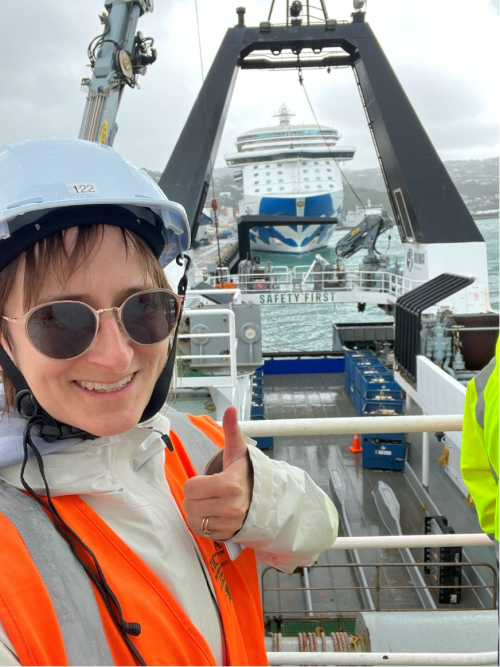
RV Tangaroa Blog – Day 1: Off to a Rocky Start

RV Tangaroa Blog – Day 1: Off to a Rocky Start
Taylor Tracey Kyryliuk
The Pacific and Australian plates are colliding off the eastern shore of New Zealand. The Pacific plate is sliding beneath the Australian plate and into the Earth’s mantle along the entire coast of the North Island. This tectonic boundary is what we know as the Hikurangi subduction zone.
There are several mysteries surrounding the Hikurangi, but the biggest mystery is why the Pacific plate has stopped sliding beneath the Australian plate near the lower North Island and Wellington city. Although the two plates are stuck together now, it is likely that at some point in the future the forces between the two plates will cause them to become un-stuck and cause a massive earthquake.
In order to better understand the Hikurangi subduction zone and why the two plates are stuck, the current project ‘Earthquakes and Locking investigation of Subduction’ (aka ELVES) was set in motion. This international project is a collaboration between Canadians and New Zealanders and was several years in the making. The use of the seismometers was funded by Toka Tū Ake EQC and GNS Science vessel time allocated by the Tangaroa Reference Group. New Zealand will provide the research vessel, the Tangaroa, and Canada will provide the equipment, ocean-bottom seismometers (aka OBSs) called the Aquarius. Our goal is to place OBSs on the ocean floor off shore the east coast of the lower North Island to find the location of faults. Knowing where the faults are will help us understand the forces between the Pacific and Australian plates, why they have become stuck together, and when we can expect a massive earthquake to occur.
 After years of delays caused by COVID19 restrictions, we finally shipped the instruments to New Zealand. With all this settled, project ELVES is a go.
After years of delays caused by COVID19 restrictions, we finally shipped the instruments to New Zealand. With all this settled, project ELVES is a go.
On the day of our departure, the morning began with bad weather. Strong headwinds delayed the arrival of the Tangaroa to Wellington. The scientific crew waited in a converted shipping container while rain and wind pelted the port. There were concerns about the weather at sea impeding the project.
With the boat docked, the scientific crew boarded the vessel and were shown their respective accommodations. Each of us were assigned our own room, which are outfitted with a bunk bed, closet, table and sofa, and a private toilet/shower. Meanwhile, the 20 OBS in their blue shipping containers were lifted onto the deck of the Tangaroa with a crane and stacked on top of each other.
Once settled, we headed up to the bridge to do a safety induction. We took a tour of the boat to see the various facilities and locations of safety gear. Impressively, the current Wi-Fi onboard is good enough quality to use social media sites.
The majority of the crew dined together for lunch in the mess. Lunch is the major meal of the day because both shifts are awake at this time. A day onboard the Tangaroa is split into two shifts for the scientific crew. Noon to midnight and midnight to noon.
Following lunch we had two “toolbox” meetings where the logistics of the cruise, news about the weather conditions and other details were discussed. Then a safety drill was executed: when an alarm is sounded, everyone aboard the Tangaroa must go to the muster point and practice donning life vests. The muster point is a designated location for the crew to meet to receive orders and do a roll call in the event of an emergency.
Soon after 16:00 the Tangaroa set sail from the harbour towards the first location where we will drop an OBS into the ocean. We should arrive there at midnight. Most members of the midnight-noon shift had retired for the night by this time. Within an hour we were experiencing large waves causing the boat to rock and making it hard to move around. Some people experienced seasickness (including myself) regardless of wearing the anti-seasickness patches.
I am on the noon-midnight shift, so I attempted to adjust to my schedule. The ship has a TV room with a large DVD collection. I passed the evening watching The Meg, a movie about a megalodon shark attacking scientists at sea. Perhaps not the best movie to watch while at sea for the first time?
I couldn’t make it to midnight due to the seasickness, but I slept incredibly well thanks to the comfy bedding and the rocking of the boat. We are looking forward to getting the OBS deployed!
18 December 2023
Disclaimers and Copyright
While every endeavour has been taken by the East Coast Lab Hikurangi Subduction Zone M9 to ensure that the information on this website is
accurate and up to date, East Coast Lab Hikurangi Subduction Zone M9 shall not be liable for any loss suffered through the use, directly or indirectly, of information on this website. Information contained has been assembled in good faith.
Some of the information available in this site is from the New Zealand Public domain and supplied by relevant
government agencies. East Coast Lab Hikurangi Subduction Zone M9 cannot accept any liability for its accuracy or content.
Portions of the information and material on this site, including data, pages, documents, online
graphics and images are protected by copyright, unless specifically notified to the contrary. Externally sourced
information or material is copyright to the respective provider.
© East Coast Lab Hikurangi Subduction Zone M9 - www.eastcoastlab.org.nz / +64 6 835 9200 / info@eastcoastlab.org.nz
